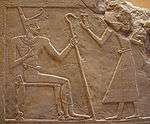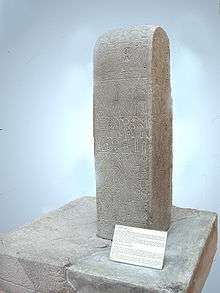Crook-staff (Luwian hieroglyph)

An ancient Egyptian heqa "crook" staff-(a less circular crook example is shown), (Gardiner S38). (Gardiner S39 has no circle-shape, only the curving end.)
The Crook (Luwian hieroglyph) is a Luwian language hieroglyph identical to the Egyptian language hieroglyph known as gardiner's S39, the common crook shape of a staff. A different crook-staff, the most common crook-staff shape from ancient Egypt is the "heqa–Crook", which is used in Egypt for ruler, governor, prince, chief, etc. For example, the Governor of On-Heliopolis.
Crook, common shape
| Wikimedia Commons has media related to Category:Luwian hieroglyphs. |
|
|
Crook of Hieroglyphic Luwian
(also found with a 'circle-shaped' end)
The Luwian crook, (Gardiner type S39), is a straight staff with a curving end.
Luwian language Lituus

Stele with 7 registers of hieroglyphs. 2 examples are in Register 6-(from bottom); both are more similar to Egypt's S38, instead of the Luwian language's S39 crook.
The 'staff' hieroglyph is called "Lituus" in a Roman-(Latin language), convention; (see the ext link: ancientscripts).
See also
External links
- The Luwian hieroglyphic script - ancientscripts.com
References
- Budge. A Hieroglyphic Vocabulary to the Book of the Dead, E.A.Wallace Budge, (Dover Publications edition), c 1991, (c 1911, original as the Kegan Paul edition). pp 281-282 for entry of heq, "sceptre, emblem of rule, ruler, governor,...etc" (softcover, ISBN 0-486-26724-5)
This article is issued from Wikipedia - version of the 9/8/2015. The text is available under the Creative Commons Attribution/Share Alike but additional terms may apply for the media files.